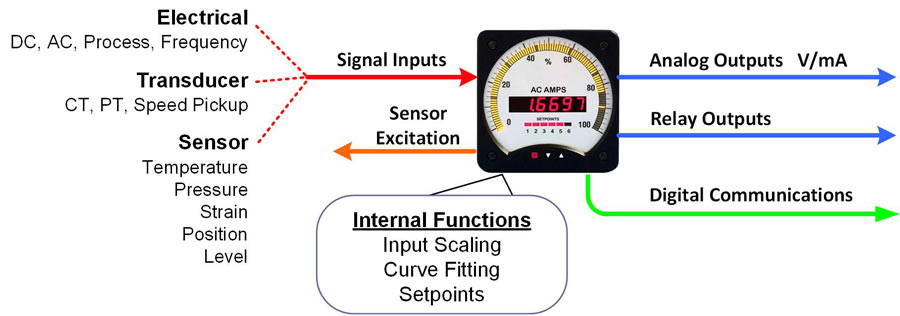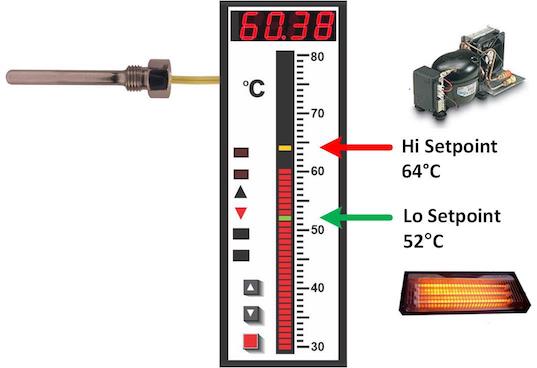Panel mount digital controllers are commonly used for process control. However, many digital panel meters (DPMs) can also perform process control functions. A panel meter is a good choice when advanced control functions, such as PID, are not required, and on/off or proportional control is sufficient. Why use a panel meter?
 DPMs are available from many suppliers, with a variety of extra functions and features. These include a wider selection of inputs (not just Vdc, mA or temperature), more display choices (color, larger digits, bargraph, etc.), and more case sizes. Programmable panel meters (with an internal CPU or microprocessor) usually have optional relay and/or analog outputs. Configuring a DPM for control is straightforward, using either of these outputs.
DPMs are available from many suppliers, with a variety of extra functions and features. These include a wider selection of inputs (not just Vdc, mA or temperature), more display choices (color, larger digits, bargraph, etc.), and more case sizes. Programmable panel meters (with an internal CPU or microprocessor) usually have optional relay and/or analog outputs. Configuring a DPM for control is straightforward, using either of these outputs.
Relay Outputs
Relay outputs are the most popular method to control with a panel meter. The typical relay option includes one to four relays with SPST (form A) or SPDT (form C) contacts. These are usually rated to switch line voltage devices up to a few amps. If the voltage, current or horsepower rating of the internal relay is inadequate to switch the load directly, an interposing relay with higher ratings may be added. The DPM performs on/off control of external devices through relay outputs with user adjustable setpoints.
 Here is an example of a heating and cooling application using a digital bargraph meter. The goal is the maintain a 50-65°C temperature in a drying chamber. The high setpoint is adjusted to 64°C (as indicted by the yellow segment in the bar display). Cooling is activated when the reading goes above this temperature. Hysteresis is set to 6°C, so cooling will shut off when the temperature drops below 58°C. The low setpoint is adjusted to 52°C (as indicated by the green segment). Heating is activated when the temperature drops below this value and continues to run until it rises to 54°C (2°C hysteresis). Both the bar and the digital display show the measured temperature. The illuminated arrow shows the signal direction (increasing or decreasing). Dual high and low setpoints (four relay outputs) can be used for systems with two stage cooling and heating.
Here is an example of a heating and cooling application using a digital bargraph meter. The goal is the maintain a 50-65°C temperature in a drying chamber. The high setpoint is adjusted to 64°C (as indicted by the yellow segment in the bar display). Cooling is activated when the reading goes above this temperature. Hysteresis is set to 6°C, so cooling will shut off when the temperature drops below 58°C. The low setpoint is adjusted to 52°C (as indicated by the green segment). Heating is activated when the temperature drops below this value and continues to run until it rises to 54°C (2°C hysteresis). Both the bar and the digital display show the measured temperature. The illuminated arrow shows the signal direction (increasing or decreasing). Dual high and low setpoints (four relay outputs) can be used for systems with two stage cooling and heating.
Analog Outputs
 An analog output is another popular way to use a digital panel meter for control. The analog output (aka analog retransmit) provides a proportional dc volt or mA signal that can be scaled to reflect the measured parameter, over all or part of the input range. This allows the output to vary the operation of an external device. Here is another temperature example, showing a DPM measuring ambient temperature in a storage shed. The objective is to change the speed of a ventilation fan based on that reading. The meter is set to the 200°F range and the analog output is scaled for 0V at 100°F, increasing linearly to 10V at 130°F. The fan drive module has a 0-10V input, so the fan begins to turn slowly at 100°F and reaches full speed at 130°F.
An analog output is another popular way to use a digital panel meter for control. The analog output (aka analog retransmit) provides a proportional dc volt or mA signal that can be scaled to reflect the measured parameter, over all or part of the input range. This allows the output to vary the operation of an external device. Here is another temperature example, showing a DPM measuring ambient temperature in a storage shed. The objective is to change the speed of a ventilation fan based on that reading. The meter is set to the 200°F range and the analog output is scaled for 0V at 100°F, increasing linearly to 10V at 130°F. The fan drive module has a 0-10V input, so the fan begins to turn slowly at 100°F and reaches full speed at 130°F.
Communication Ports
A third method to use a panel meter for control is through its communication port. In this arrangement, the meter passes the measured process value to the computer system. The computer then initiates the appropriate control action. The meter serves as a sensor interface, analog to digital converter and local display. Its relays can be used for alarms or a second level of control, such as a backup limit or safety shutdown.
Many digital process controllers include temperature measuring capability, so they could be used in the two simple applications shown above. However, when the process signal requires a different type of sensor, or involves an ac voltage, ac or dc current, or a dc voltage greater than 10V, the panel meter is likely a better choice. Other application requirements may also favor a panel meter over a controller.
See the full list of Weschler application postings for information on bargraph meters, meter relays, setpoint and hysteresis, relay contact protection, and other topics related to this article.
